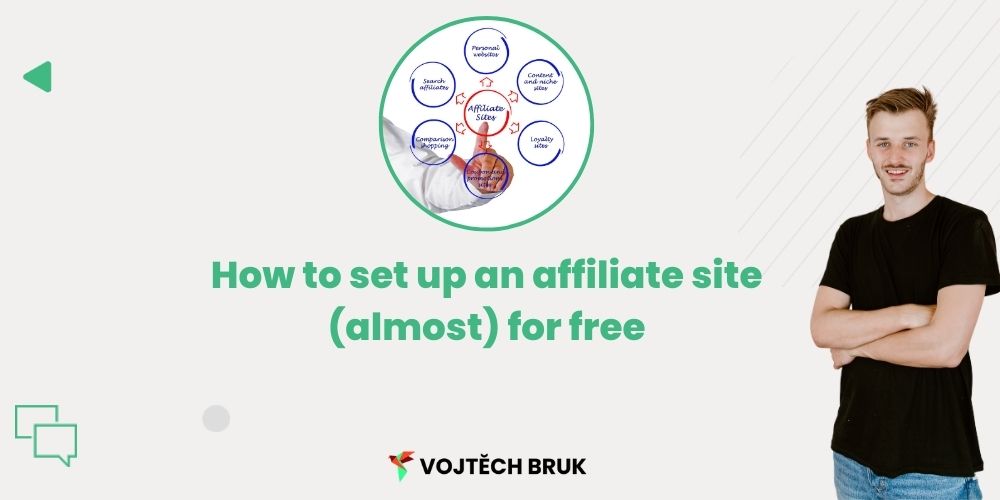Affiliate marketing I introduced last time. Today, we’ll look at how you can set up your affiliate site with minimal cost and start building it.
We’ll demonstrate the process with a concrete example, so you’ll be able to see that it’s really possible and if you’re well-versed in the online world, it’s not even difficult.
How much will it cost?
It depends on what tools and platforms you decide on, however the basic items are:
- Domain (175 CZK per year)
- Hosting (some suboptimal 60 CZK/month)
- WordPress – free
- Licence on SEO tools – can use those for free
So in total, the first year of running your affiliate site will cost you 895 CZK + your time.
If you want to create a free website you can check out the Elementor course on creating a free website. You can also find it on YouTube.
For the affiliate sites I will be setting up as part of this article, however, I will also be using paid tools (to save time).
But I’m sure it’s possible to go through the whole process with free tools.
Selecting a program niche(s)
A niche is the area to which your site will be devoted.
It can be:
- fishing,
- cultural studies,
- SEO…
most anything.
The important thing is:
- that the niche has the potential to be monetized,
- enjoyed (otherwise you won’t enjoy filling the site with content and taking care of it)
Once you have chosen a niche, you can look around to see if there are specific affiliate programs that you can use to monetize the niche.
Affiliate Directory is a good place to start this research. And don’t be fooled, a good affiliate program is almost as important as a good niche.
Personally, I’ve been tempted for some time to try and create an affiliate site for handicrafts/instructions. While I’m not the creative type (I don’t meet one of the two requirements), I’m attracted by the low competition, large searches and good monetization potential.
While I don’t enjoy creating, I do enjoy SEO, so I’ll enjoy creating content anyway.
However, if you have the option, I really strongly recommend choosing an area you’re close to.
Domain Selection
To help you choose a website name, the How to Choose a Domain Name article may help, however anything simple and memorable should work.
For our needs, names like the following might be good:
Domain availability can best be verified using, for example, the Wedos Availability Verifiability Tool:

If the domain is free, feel free to register it. As a bonus, you may be able to find a domain that has been active in the past, so the search engines already “know” it. Unless it is a domain from, for example, the adult industry, the chances of it carrying some sort of penalty are minimal (acceptable to me).
To estimate whether a domain has been used, for example, you can use the Ahrefs backlink checker:

You can see that the domain rukodelky.cz probably existed at some point, but it doesn’t have any links or statistics behind it.
The mojetvoreni.cz domain is a bit better off:

The backlinks aren’t very high quality, but I still believe it will be easier to start with this domain than completely greenfield.
So for our experiment, we’ll choose this domain.
I’ll register it using Wedos. I’ll connect it to my hosting and install WordPress. I describe the whole process in this video.Creating the Web
You can try creating a website using the tutorial above, or have a professional create one for you. There are plenty of options for creating a website from start to finish.
To save speed, I choose a template from Envato Elements and upload it right to my site to make the start as fast as possible.

After this step, the site is basically ready to be populated with content and then promoted.
Filling the site with content
It’s best to start with keyword analysis and build a new site from scratch with analysis in mind. You can do primitive keyword analysis on your own (even if it’s just using Google whisperer and Ahrefs free tools).It’s important that your pages revolve around your chosen topic in a way that people who are looking for them will find them.
Once you have your site set up, you have to decide how to get visitors to it.
Choose your traffic sources
There are countless ways you can promote your site:
- Facebook,
- Search Engines (SEO),
- Newsletter,
- TikTok,
- LinkedIn,
- Pinterest,
- and a host of other options…
Personally, I choose SEO + supplemental resource for almost all projects.SEO optimization is a long run, but I’m convinced it’s worth it. Once SEO is up and running, you don’t have to touch the site for weeks and something is still happening.
The inertia of SEO is huge compared to social media efforts.
So I would choose SEO in this case as well.
As a second marketing channel, I would choose Pinterest. It may not be a very well-known network, but it still has
1) high traffic,
2) ideal for the industry/purpose,
3) the longevity of content on Pinterest is multiples compared to other networks.
Why not choose multiple feeds?
Because it will split your focus. And believe me, even if you manage to drive visitors from two channels, your affiliate site will be (very) successful.
You can add more networks at any time in the future – for example, once you have someone helping you with the site.
Create a content calendar and content
Once you have your promotional channels selected, you’ll need a plan for creating content to promote on them. Probably the easiest way to create a plan is to find keyword searches and then plan your content around those words.Optimal publishing frequency is individual, but in general I guess you could say Publish as much as you can handle in the long term. The word long term is key. ****And some people can manage two articles a month long term, and some people can manage two articles a week.
It’s important not to complicate things. You can always edit content and still not know what will and won’t catch on. If you have a problem with ideas and constant content production, you might find the article How to Constantly Produce New Content interesting.How to make it as easy as possible for yourself
It’s easiest if you have the option to hire someone to do it for you and outsource the part of the process that you find least fun.
It does cost money, but in my opinion it is a great investment.
If you then want to use social networks to promote as well, I highly recommend using a content planner. For example, Publer is free and will make your life a lot easier.
Word in conclusion
Affiliate sites are a long-distance run. However, if you have a sincere interest in an industry that you find worth monetizing with an affiliate site, feel free to take the plunge.
The rewards are enticing and scalable.
I’ll keep you posted on the fate of the mojetvoreni.cz domain that I registered while writing this article. Probably in the form of an update to this article in the future. So you can look forward to specific numbers and other important details.
By signing up for the newsletter, you’ll be sure not to miss updates.
Thanks for reading this far, and let me know – do you have any experience with affil sites yourself?





